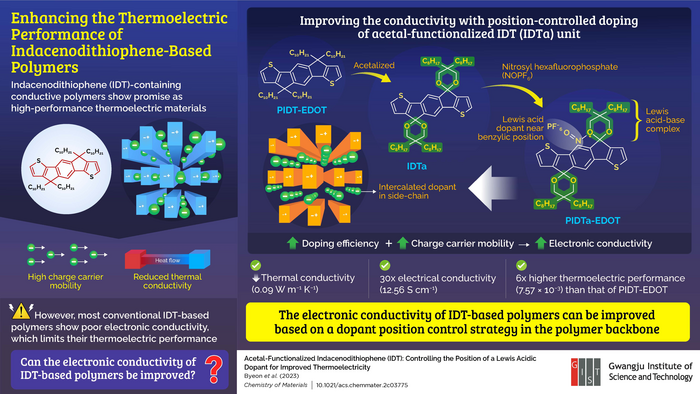Thermoelectric materials, substances that convert temperature difference into electricity, find a multitude of applications involving the conversion of waste heat into useful electrical energy. However, they often need to rely on heavy rare earth elements for efficient thermoelectric conversion. This, unfortunately, makes them expensive and environmentally hazardous. In recent years, conjugated polymer-based material has received attention as an environmentally benign alternative to the conventional rare earth metal-based thermoelectric materials.

Credit: Sukwon Hong from Gwangju Institute of Science and Technology
Thermoelectric materials, substances that convert temperature difference into electricity, find a multitude of applications involving the conversion of waste heat into useful electrical energy. However, they often need to rely on heavy rare earth elements for efficient thermoelectric conversion. This, unfortunately, makes them expensive and environmentally hazardous. In recent years, conjugated polymer-based material has received attention as an environmentally benign alternative to the conventional rare earth metal-based thermoelectric materials.
Owing to their high charge carrier mobility in the amorphous state, IDT-containing conductive polymers have the potential to reduce thermal conductivity while keeping their electronic conductivity intact. Unfortunately, these polymers suffer from low electronic conductivity, limiting our ability to synthesize high-performance thermoelectric materials from IDT-based polymers.
A team of researchers led by Prof. Sukwon Hong Gwangju Institute of Science and Technology in Korea have now found a solution to the problem. Equipped with their understanding of plausible reasons for the observed low conductivity, the team designed a novel strategy for developing an IDT-based polymer with improved thermoelectric performance based on dopant (impurity) position controlling within an acetal-functionalized IDT (IDTa) polymer. Their study was made available online on March 2, 2023 and was published in Volume 35, Issue 5 of the journal Chemistry of Materials on March 14, 2023.
The team chose PIDT-EDOT, a copolymer of IDT and then acetal-functionalized it to form PIDTa-EDOT. Next, they synthesized a Lewis-acid base complex by introducing nitrosyl hexafluorophosphate (NOPF6), a Lewis acidic dopant into the IDTa component. The addition of the acetal group was crucial, since it directed the dopant next to the benzylic position of the polymer skeleton, facilitating the desired dopant position control.
“We showed that the low conductivity of conventional IDT results from their non-polar side chains, which cause the dopant to be located between the polymer chains (backbone) instead of at the side chains. This, in turn, impedes charge transfer. Accordingly, we proposed a strategy that would allow us to place the dopant near the sidechains of the polymer backbone,” explains Prof. Hong, when asked about the motivation behind the study.
Upon testing the PIDTa-EDOT polymer, the researchers observed an improved doping efficiency, condensed π−π stacking, and reduced grain size. These, in turn, imparted a low thermal conductivity of 0.09 W m−1 K−1 on one hand and 30 times higher electronic conductivity on the other. As a result, the PIDTa-EDOT polymer demonstrated a 6-fold improvement in thermoelectric performance compared to that of pristine PIDT-EDOT polymer.
The study thus presents a new approach to synthesizing IDT-based polymers that simultaneously exhibit low thermal conductivity and high electronic conductivity, a prerequisite for developing efficient thermoelectric materials and thermoelectric conversion technology. “Improved thermoelectric materials could lead to more efficient electricity generation from the waste heat released in industrial processes or even from the human body. This, in turn, could reduce energy consumption and make solar power more practical and cost-effective,” concludes an optimistic Prof. Hong.
***
Reference
DOI: https://doi.org/10.1021/acs.chemmater.2c03775
Authors: Jinhwan Byeon1, Dowon Kim1, Minkyu Kyeong2, In Gyu Bak3, and Sukwon Hong1
Affiliations:
1Department of Chemistry, Gwangju Institute of Science and Technology, Republic of Korea
2 Dow Inc., Republic of Korea
3 School of Materials Science and Engineering, Gwangju Institute of Science and Technology, Republic of Korea
About the Gwangju Institute of Science and Technology (GIST)
The Gwangju Institute of Science and Technology (GIST) is a research-oriented university situated in Gwangju, South Korea. Founded in 1993, GIST has become one of the most prestigious schools in South Korea. The university aims to create a strong research environment to spur advancements in science and technology and to promote collaboration between international and domestic research programs. With its motto of “A Proud Creator of Future Science and Technology,” GIST has consistently received one of the highest university rankings in Korea.
Website: http://www.gist.ac.kr/
About the author
Sukwon Hong is a Professor of Chemistry at Gwangju Institute of Science and Technology (GIST), Korea. He received his PhD in Chemistry from Northwestern University, USA. Before joining GIST, he worked as assistant professor at the University of Florida till 2012. His current areas of research include development of organometallic catalyst for asymmetric reaction, ethenolysis, CO2 chemistry, and photochemistry. The Hong group at GIST has been working on developing functional molecules for energy conversion technology, including solar cells and thermoelectric materials.
Journal
Chemistry of Materials
DOI
10.1021/acs.chemmater.2c03775
Method of Research
Experimental study
Subject of Research
Not applicable
Article Title
Acetal-Functionalized Indacenodithiophene (IDT): Controlling the Position of a Lewis Acidic Dopant for Improved Thermoelectricity
Article Publication Date
14-Mar-2023
COI Statement
The authors declare no competing financial interest




